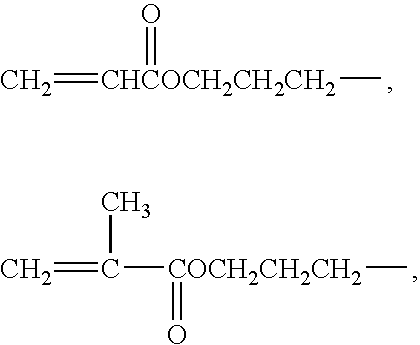Non-aqueous electrolyte secondary battery negative electrode material, making method, and lithium ion secondary battery
a secondary battery and negative electrode technology, applied in the manufacture of electrodes, cell components, electrochemical generators, etc., can solve the problems of insufficient conductivity, insufficient discharge capacity, and failure to meet the requirements of the method to achieve the effect of increasing charge/discharge capacity and energy density
- Summary
- Abstract
- Description
- Claims
- Application Information
AI Technical Summary
Benefits of technology
Problems solved by technology
Method used
Image
Examples
example 1
[0053] First, 100 pbw of vinyltrimethoxysilane (trade name KBM1003 by Shin-Etsu Chemical Co., Ltd.) as the silane coupling agent was dissolved in 100 pbw of methanol to form a 50% methanol solution. 200 pbw of the 50% methanol solution was dissolved in 100 pbw of deionized water to form an aqueous solution. Then 1 pbw of this aqueous solution was dissolved in 100 pbw of methanol to form a treating solution. To 100 pbw of the treating solution was added 100 pbw of a ceramics grade metallic silicon powder having an average particle size of 3.5 .mu.m and a BET specific surface area of 4 m.sup.2 / g. They were mechanically agitated for 1 hour to achieve thorough mixing. The resulting slurry was then filtered and dried, obtaining the metallic silicon powder treated with the silane coupling agent. Next, the treated metallic silicon powder was placed in a rotary kiln where chemical vapor deposition was carried out in an Ar / CH.sub.4 gas atmosphere at 1200.degree. C., yielding a non-aqueous el...
example 2
[0059] A non-aqueous electrolyte secondary battery negative electrode material was prepared by the same procedure as in Example 1 except that a silicon oxide powder of SiO.sub.x (x=1.02) having an average particle size of 1.1 .mu.m and a BET specific surface area of 10.3 m.sup.2 / g was used as the base. The negative electrode material thus obtained was a conductive powder having an average particle size of 1.5 .mu.m, a BET specific surface area of 20.3 m.sup.2 / g and a graphite coating weight of 24%.
[0060] As in Example 1, a test battery was fabricated using this conductive powder and similarly tested. The lithium ion secondary battery had a 1st cycle charge / discharge capacity of 975 mAh / g, a 1st cycle discharge capacity of 780 mAh / g, a 1st cycle charge / discharge efficiency of 80%, a 50th cycle discharge capacity of 773 mAh / g, and a cycle retentivity of 99% after 50 cycles, indicating excellent cycle performance, despite a less capacity than in Example 1.
example 3
[0061] A non-aqueous electrolyte secondary battery negative electrode material was prepared by the same procedure as in Example 1 except that y-methacryloxypropyltrimethoxysilane (trade name KBM503 by Shin-Etsu Chemical Co., Ltd.) was used as the silane coupling agent. The negative electrode material thus obtained was a conductive powder having an average particle size of 4.4 .mu.m, a BET specific surface area of 14.3 m.sup.2 / g and a graphite coating weight of 27%.
[0062] As in Example 1, a test battery was fabricated using this conductive powder and similarly tested. The lithium ion secondary battery had a 1st cycle charge / discharge capacity of 1312 mAh / g, a 1st cycle discharge capacity of 1194 mAh / g, a 1st cycle charge / discharge efficiency of 91%, a 50th cycle discharge capacity of 1015 mAh / g, and a cycle retentivity of 85% after 50 cycles, indicating a high capacity and excellent cycle performance.
PUM
 Login to View More
Login to View More Abstract
Description
Claims
Application Information
 Login to View More
Login to View More - R&D
- Intellectual Property
- Life Sciences
- Materials
- Tech Scout
- Unparalleled Data Quality
- Higher Quality Content
- 60% Fewer Hallucinations
Browse by: Latest US Patents, China's latest patents, Technical Efficacy Thesaurus, Application Domain, Technology Topic, Popular Technical Reports.
© 2025 PatSnap. All rights reserved.Legal|Privacy policy|Modern Slavery Act Transparency Statement|Sitemap|About US| Contact US: help@patsnap.com

